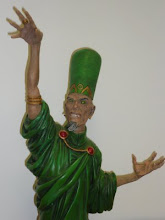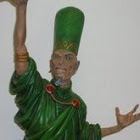
Excellent swashbuckling adventures combining well crafted plots, swift action and a strongly developed cast into first rate Zorro stories. The first story "Tusk Envy" is set among the La Brea tar pits where it appears Zorro has been trapped by Captain Monasterio and Quickblade. At the same time a giant skeleton has risen up from the tar, disturbed by an earthquake and a local farmer and his son are trying to salvage. The constrained locale and the desperate fight Zorro has on his hands is inter cut neatly with the attempts to get the skeleton out of the tar. The action is concentrated and the skeleton has a sharp surprise in store. The second story "Dead Body Rising" continues directly from the first as the body of a murdered Indian woman rises to the surface. This story has some clever use of continuity from the first story as well as a much more extensive cast and setting. There is a furious chase and a very dangerous carriage journey as Zorro demonstrates both his compassion, will courage and sheer adventurous spirit. Best of all so does Eulalia Bandini, a waitress at the local cantina who shows sparkling, witty courage that all to many female characters are denied.
These stories succeed on a number of levels, each of them impressive in their own right, collectively they are a triumph. The stories are superb Zorro stories, not simply masked adventurer stories, they are very specifically Zorro stories. The details of the context that define them are firmly involved, not just the dual identity, it is also the relationship with his father and the native Indians and the poor that gives Zorro his depth and place. The lighthearted adventurer covering the deep compassion is shown clearly and naturally, victory is hard fought and the struggle ongoing.
The strips avoid the common problems of newspaper adventure strips, they do not slow down to recap to allow occasional readers catch up and follow. They have a strong narrative flow and the changes in action allow the story to be picked up at a lot of points and still be coherent. The art is clear and flowing, it has as much detail as the small format allows for without being crowded. The carriage chase in the second story has a remarkable degree of dynamism, the restricted space is utilised to give the action tension and economy. Excellent comics.





















